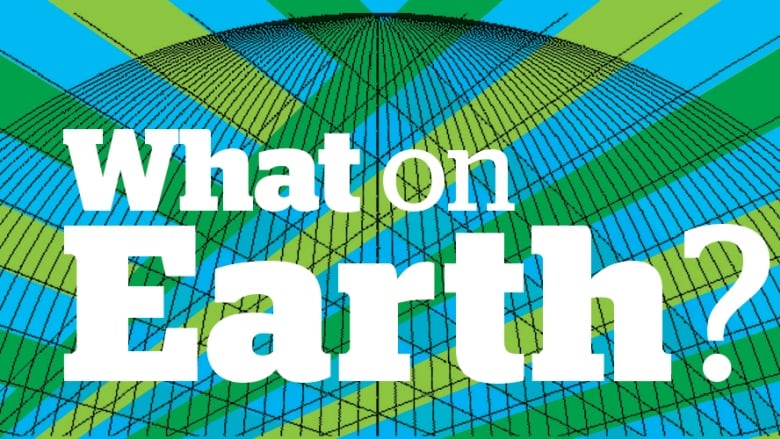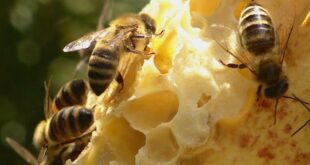Also: Food waste is a climate change issue

Our planet is changing. So is our journalism. This weekly newsletter is part of a CBC News initiative entitled "Our Changing Planet" to show and explain the effects of climate change. Keep up with the latest news on our Climate and Environment page.
Sign up here to get this newsletter in your inbox every Thursday.
This week:
- Christmas trees have the potential to spread unwanted critters
- What has 2 (or 3) wheels and helps reduce oil consumption?
- Here's why food waste is a major climate change issue
Christmas trees have the potential to spread unwanted critters

Three years ago, an owl made headlines after being found in a Christmas tree that was about to be put up at 30 Rockefeller Plaza in New York City.
Trees provide habitat for wildlife, and that's a good thing. But it also means that Christmas trees can carry a variety of live cargo with them when they travel — and many aren't as harmless as "Rockefeller" the owl.
The Centre for Agricultural Biosciences International, a non-profit organization focused on science-based solutions for agriculture and the environment, lists the 12 pests of Christmas trees on its invasive species blog. The list includes the Western yellowjacket, a wasp native to western North America whose young queens spend the winter in species often exported as Christmas trees.
This has caused a huge problem in Hawaii, which imports about 90,000 Christmas trees a year, mostly from Oregon. At least two strains of the invasive Western yellowjacket are thought to have been introduced from imported live Christmas trees in the 20th century.
The wasps are voracious predators that have eaten their way through local insect populations, competing with native birds and insects.
In order to reduce the importation of wasps and other critters, including garter snakes and slugs carrying the rat lungworm parasite, a certain proportion of trees imported to Hawaii are shaken, either mechanically or by hand, before shipping and after arrival. Infested trees may be sent back to the shipper, or "treated" with more shaking or hot water (to remove slugs).
Hawaii isn't the only place that imports Christmas trees and is concerned about hitchhikers.
Canada is a net Christmas tree exporter, but also imports some. In 2022, Canada exported 2.4 million trees worth $98 million, Agriculture Canada reports, mostly from Quebec, Nova Scotia and New Brunswick.
More than 95 per cent went to the U.S., but some also went to Panama, many Caribbean countries, Venezuela and the United Arab Emirates.
One pest of concern that can move between Canada and the U.S. via Christmas trees is the LDD or spongy moth, formerly called the gypsy moth. It can also be a concern with trees moving between different parts of Canada; it caused the shutdown of at least two Christmas tree lots in Thunder Bay, Ont., last year.
According to the Canadian Food Inspection Agency, trees moving from "regulated" Canadian areas infested with the moth to non-infested U.S. areas need a "phytosanitary certificate" saying they've been inspected and have either been found free of moths or have been treated for it.
Those from non-infested areas need a "certification of origin." Similar guidelines apply for trees moving from the U.S. to Canada, while trees moving within Canada from regulated to non-infested areas need a "movement certificate."
Canada does import a small number of trees from the U.S., says Shirley Brennan, executive director of the Canadian Christmas Trees Association. Mostly, they go to B.C. and the Prairies.
The main species of concern in B.C. is an invasive European insect called the balsam woolly adelgid. In order to prevent its spread, from Nov. 1 to Jan. 31 each year, B.C. requires phytosanitary certification for Christmas trees from certain counties in Oregon and California saying they're free of the pest. At other times of the year, cut fir trees typically can't be imported.
Brennan says protocols put in place to curb the spread of invasive species are "so important" and have been effective at keeping balsam woolly adelgid out of imported Christmas trees for the past decade.
There is a way to eliminate the risk of invasive species altogether — by buying locally grown Christmas trees. While that's easier to do in places like Canada, it's also something the Maui invasive species committee recommends. The group encourages Hawaiians to celebrate the festive season with tree species that grow in the local climate, including Monterey pines, Norfolk pines or Alahe'e trees.
— Emily Chung
Old issues of What on Earth? are here. The CBC News climate page is here.
Check out our podcast and radio show. This week: We hear why the final agreement at the COP28 climate talks in Dubai might be "sounding the death knell for the fossil fuel era." What On Earth drops new podcast episodes every Wednesday and Saturday. You can find them on your favourite podcast app, or on demand at CBC Listen. The radio show airs Sundays at 11 a.m. ET, 11:30 a.m. in Newfoundland and Labrador.
Watch the CBC video series Planet Wonder featuring our colleague Johanna Wagstaffe here.
Reader feedback
Margaret Lamoure wrote in to comment on a story Emily Chung did a couple of weeks ago on Coca-Cola's plan to bring '100%' recycled bottles to Canada:
"I am teaching in a small community in Barra Ciega, El Salvador. No kudos to Coca-Cola here. Until Coca-Cola ensures recycling is available everywhere they sell their products, they have nothing to crow about. This small community has no access to recycling, so their beautiful beach is riddled with bottles…. The bags we collected are still sitting on the beach a week later. What incentive do people have to clean the environment if there is no mechanism to recycle?
"This community needs a voice. They are beautiful souls living in a broken system. Coca-Cola could and must do more!"
Write us at whatonearth@cbc.ca.
Have a compelling personal story about climate change you want to share with CBC News? Pitch a First Person column here.
The Big Picture: The other electric vehicle revolution

There's been a lot of debate recently about the state of the electric vehicle transition. Many commentators have suggested the pace of sales has slowed, while other, more bullish observers post charts on EVs' inexorable rise. (Then there's Tesla, the world's most famous EV maker, which just had to recall two million vehicles in North America over its autopilot feature.)
The reason the discussion can become so heated is because electrifying transport is a key plank of global plans to reduce carbon emissions. But as a recent New York Times feature pointed out, significant change is already happening — just maybe not in the types of vehicles most Westerners drive.
In countries like Kenya, Rwanda, China and India, electric two- and three-wheeled vehicles — from motorcycles to rickshaws — are becoming more common. These non-cars are vital in moving people around in urban centres, and the battery-powered versions are putting a significant dent in oil consumption. Bloomberg New Energy Finance estimates that electric two- and three-wheelers are displacing more than one million barrels of oil a day worldwide.
Hot and bothered: Provocative ideas from around the web
-
As the COP28 climate summit went into overtime, world leaders agreed on the idea of "transitioning away from fossil fuels in energy systems." While the deal was groundbreaking for recognizing the need to move away from fossil fuels, it was criticized for not being the fossil fuel "phase out" that some countries and environmental activists had called for.
- The Quebec town of Prévost passed a bylaw banning natural gas this fall. Since then, it has been hit with a lawsuit from Quebec's gas utility, Énergir. The National Observer looks into the implications.
- China has been rolling out an EV bus network since the 2010s. That has shaped the transition to EVs not just in China, but the world, BBC reports.
- The city of Roubaix in France has taught hundreds of volunteers how to live as waste-free as possible. Not only did that cut waste significantly, but it also saved many families the equivalent of about $1,400 US a year. Now it's expanded its waste education and initiatives to schools and businesses.
Here's why food waste is a major climate change issue

In the drive to reduce greenhouse gas emissions, most people focus on the biggest source — the burning of fossil fuels, responsible for 75 per cent of global emissions, according to the UN.
But there's another source that many believe needs to be addressed, one that largely goes unnoticed — food waste.
Food releases large amounts of methane, a greenhouse gas 80 times more potent in terms of warming than carbon dioxide as it breaks down over 20 years. And the more food that's wasted, the more methane it produces.
Emissions from global food loss and waste are so large that if the problem were represented as a country, it wouldfall in third place behind China and the United States, according to the UN Environment Program.
At COP28 in Dubai, U.A.E., last week, more than 130 countries signed the Leaders Declaration on Sustainable Agriculture, Resilient Food Systems and Climate Action, with a goal of reducing food loss and waste and greenhouse gas emissions in the food chain.
In a 2019 report called "The Avoidable Crisis of Food Waste," Toronto-based charity organization Second Harvest found that more than half of the food in Canada — roughly 58 per cent — is wasted each year. (To be clear, food loss comes from production, handling and storage, and processing and manufacturing; food waste is considered to come from distribution, retail and households.)
The United Nations estimates that, globally, in 2019,931 million tonnes of food waste was generated, with 61 per cent coming from households, 26 per cent from the food service sector and 13 per cent from retail.
Lori Nikkel, CEO of Second Harvest, disputes that household number.
"In the past, people used to think it's all about household [waste], which is true — there's some household waste, but it's a systems issue," she said. "When you look at where most [waste] is happening, it's further up the supply chain."
Second Harvest's analysis, done in partnership with Value Chain Management International, a consulting business with expertise in food waste, found that 58 per cent of food loss in Canada came from production and processing. Household waste only accounted for five per cent and retail slightly more than one per cent.
In developing countries, one of the challenges is that infrastructure may not be in place to prevent food loss.Research from the University of Sheffield's institute for sustainable food out of the U.K. found that in some warmer countries, technology may not be in place to prevent food from spoiling.
Nikkel said that in Canada, there's a different problem.
"We just overproduce [food]. So you might have things that are lost in the field, or we have supply-managed stuff, which is why you see milk getting dumped a lot," Nikkel said. "Or fisheries. We overfish, and things get caught in the net or you miscalculate what your orders are going to be or you don't miscalculate and somebody cancels an order."
Another issue with farming is that sometimes the food grown doesn't meet requirements set out by stores. Fruits or vegetables may not meet appearance or size standards. That produce is then wasted.
Meanwhile in households, people may overshop, can't shop daily or run to the grocery store every few days, as is more commonly seen in Europe, said Kate Parizeau, an associate professor at the University of Guelph's department of geography, environment and geomatics.
Another issue is something she referred to as the "halo effect." When our food goes to waste in our homes, we throw it in the green bin, thinking that we're doing something good. But it's still wasted.
Organizations such as Second Harvest and the Global FoodBanking Network partner with restaurants and major grocery chains to recover food and distribute it to those in need. There are also apps such asToo Good to Go andFlashFood (a Canadian company) that aim to put either expiring or leftover food into consumers' hands at discounted prices.
While food waste may not be top of mind for most people, it is something that is being targeted globally. The United Nations has set out 17Sustainable Development Goals (SDGs), and No. 12 is to "ensure sustainable consumption and production patterns."
Breaking it down further,SDG 12.3 aims to halve per capita food waste at every level by 2030. Parizeau says change is absolutely necessary.
"For us to be able to have the luxury of wasting up to 30 per cent of our food — we're just not going to live in a planetary system that allows for that to happen for much longer."
— Nicole Mortillaro
Stay in touch!
Are there issues you'd like us to cover? Questions you want answered? Do you just want to share a kind word? We'd love to hear from you. Email us at whatonearth@cbc.ca.
Sign up hereto get What on Earth? in your inbox every Thursday.
Editor: Andre Mayer | Logo design: Sködt McNalty

Add some “good” to your morning and evening.
A variety of newsletters you'll love, delivered straight to you.
*****
Credit belongs to : www.cbc.ca
 MaharlikaNews | Canada Leading Online Filipino Newspaper Portal The No. 1 most engaged information website for Filipino – Canadian in Canada. MaharlikaNews.com received almost a quarter a million visitors in 2020.
MaharlikaNews | Canada Leading Online Filipino Newspaper Portal The No. 1 most engaged information website for Filipino – Canadian in Canada. MaharlikaNews.com received almost a quarter a million visitors in 2020.







